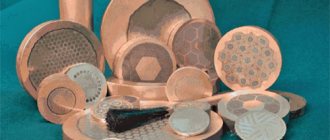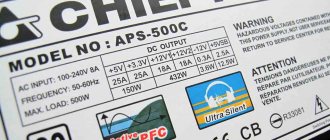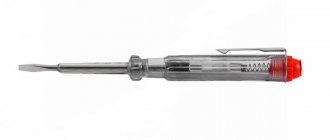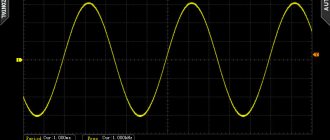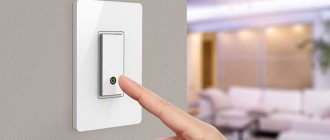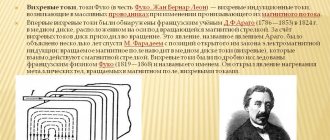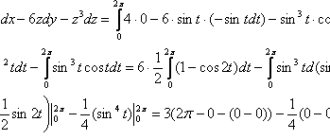Pulsating current.
click on the picture to enlarge
A pulsating current is a current that has one direction and varies in magnitude
click on the picture to enlarge
The pulsating current consists of a direct component and an alternating component.
It can be broken down into these components
Let us prove that if there is both direct and alternating current in a circuit, then the resulting current will be pulsating.
click on the picture to enlarge
In the first quarter of the alternating current period, the alternating and direct current in the circuit flow in the same direction, the resulting current in the circuit will increase from zero to maximum, since in the first quarter the resulting current will be equal to the sum of the currents.
In the second quarter of the period, the alternating current drops from the maximum to zero, which means the resulting current will decrease to the value of the direct current.
In the third quarter of the alternating current period, the voltage polarity on the generator will change + from right to left. This means that in the third quarter the alternating current will go against the direct current of the battery, therefore the resulting current in the third quarter will be equal to the direct current minus the alternating current.
In the fourth quarter of the period, the alternating current continues to go against the direct current, but it decreases from a maximum to zero, which means the resulting current will increase to the value of the direct current. Thus, it is true that if there is both direct and alternating current in a circuit, then the resulting current will be pulsating.
The above will be true if the magnitude of the constant component is greater than the amplitude of the alternating current.
Pulse electric currents
Pulsed currents are electrical currents supplied to the patient intermittently in the form of individual jolts (impulses) with pauses between them. Pulse currents are distinguished by the shape, frequency (in hertz - Hz) and duration (in milliseconds - ms) of pulses and pauses between them, as well as by the direction and nature of the modulations. In pulse mode, both direct and alternating electric current can be used.
The mechanism of the physicochemical action of a constant low-frequency pulsed electric current is that all changes in tissues occur discretely depending on the frequency of the impulses, and the degree of their severity and physiological effect are determined by the shape, duration of the impulse and the functionality of the excitable tissues.
The use of low-frequency pulsed currents is based on the teachings of I.E. Vvedensky about the physiological rhythms of nervous processes. By selecting the appropriate frequency and shape of impulses to which a given excitable tissue responds with the most pronounced effect, it is possible to stimulate the functions of tissues and organs. If the frequency of impulses exceeds physiological capabilities, inhibition of function occurs. Depending on the shape of the impulse, stimulation or inhibition (analgesia) of organ function is achieved.
Advantages of pulse currents:
— a selective effect is achieved on a specific organ or system whose functions are impaired;
— the specific effect of each applied physical factor appears more clearly;
— a deeper therapeutic effect is observed with the least stress on the body;
— the adaptation of tissues and organs to the physical factor develops more slowly.
Pulse currents have a pronounced antispastic, analgesic, vasodilator, trophic-regenerative effect, and actively affect the neuromuscular system of organs.
Electrosleep is the therapeutic effect of pulsed currents of a rectangular shape, low frequency (1 - 130 Hz), lasting 0.2-2 ms on brain structures. The electric current penetrates into the cranial cavity through the openings of the orbits and has a direct effect on the sensory nuclei of the cranial nerves and hypnogenic centers of the brain stem: the hypothalamus, pituitary gland, inner surface of the pons, reticular formation.
Electrosleep is a method of neurotropic non-drug therapy that helps restore the coordinated functioning of self-regulatory systems disrupted as a result of various diseases, causing a state close to physiological sleep.
Indications:
diseases of the central nervous system - neurasthenia, reactive and asthenic conditions, sleep disorders, logoneurosis, enuresis, migraine; diseases of the cardiovascular system - neurocirculatory dystonia of the hypertensive type, hypertension stages I - II; peptic ulcer of the stomach and duodenum, bronchial asthma, neurodermatitis, eczema.
Contraindications:
epilepsy, diencephalic syndrome, cardiac arrhythmia of organic origin, inflammatory eye diseases, weeping dermatitis of the face, electric current intolerance.
Electroson devices in various modifications are used to carry out procedures.
Electrical stimulation is the therapeutic use of pulsed currents to restore impaired functions of tissues and organs. Electrical stimulation as a therapeutic method is used not only in physiotherapy, but also in resuscitation (cardiac defibrillation) and cardiac surgery (wearable and implantable pacemakers). In physiotherapy, electrical stimulation is used to influence damaged nerves and muscles, as well as internal organs containing smooth muscle elements in their walls (bronchi, gastrointestinal tract, urinary system).
The contraction and relaxation of muscle fibers that occur during electrical stimulation contribute to an increase in the content of high-energy compounds in the sarcoplasm, their enzymatic activity increases, the rate of oxygen utilization increases, blood supply and lymph flow improve, which leads to an increase in trophoenergetic processes.
Electrical stimulation is carried out by applying a pulsed current to the affected motor nerve or muscle. Before starting electrical stimulation, it is recommended to conduct electrodiagnostics - the use of pulsed current to determine the initial functional properties of the affected nerves and muscles, depending on their response to electrical impulses and determining their characteristics. Classical electrodiagnostics are carried out using the motor points of nerves and muscles, their location is given in special Erb tables, the UEI-1 and others are used with a pulse frequency of 0.5-1200 Hz and a duration of 0.02-300 ms.
Various types of pulse currents are used to carry out electrical stimulation:
- current with pulses of a pointed triangular shape (tetanizing current, frequency 100 Hz, pulse duration 1.0 - 1.5 ms);
— current with an exponential pulse shape (frequency 8 – 80 Hz, pulse duration 3 – 60 ms).
The sources of these types of currents are devices such as ASM, UEI-1, etc. More complex types of currents are also very widespread: diadynamic (Bernard currents), sinusoidal modulated, etc.
Diadynamic therapy is a method of therapeutic impact on the body with diadynamic currents, which are a type of constant pulsed semi-sinusoidal currents that can be supplied in various operating modes.
Diadynamic currents have myoneurostimulating, analgesic, and vasotrophic effects. Used in the treatment of scars, muscle contractures, and joint stiffness.
Indications:
acute and subacute diseases of the peripheral nervous system; acute, traumatic injuries of the musculoskeletal system; diseases accompanied by pain and impaired peripheral circulation (obliterating vascular diseases, vasospasms, etc.); dyskinesia of the stomach, intestines, gall bladder, urinary tract.
Contraindications:
urinary and cholelithiasis, bone fractures and joint dislocations with non-immobilized bone fragments; thrombophlebitis, psychosis.
Devices used: “SNIM-1”, “Tonus-1, 2”, “Biopulsator”, etc. For exposure to diadynamic currents, electrodes similar to those used for galvanization are used.
Pulsed currents are electrical currents supplied to the patient intermittently in the form of individual jolts (impulses) with pauses between them. Pulse currents are distinguished by the shape, frequency (in hertz - Hz) and duration (in milliseconds - ms) of pulses and pauses between them, as well as by the direction and nature of the modulations. In pulse mode, both direct and alternating electric current can be used.
The mechanism of the physicochemical action of a constant low-frequency pulsed electric current is that all changes in tissues occur discretely depending on the frequency of the impulses, and the degree of their severity and physiological effect are determined by the shape, duration of the impulse and the functionality of the excitable tissues.
The use of low-frequency pulsed currents is based on the teachings of I.E. Vvedensky about the physiological rhythms of nervous processes. By selecting the appropriate frequency and shape of impulses to which a given excitable tissue responds with the most pronounced effect, it is possible to stimulate the functions of tissues and organs. If the frequency of impulses exceeds physiological capabilities, inhibition of function occurs. Depending on the shape of the impulse, stimulation or inhibition (analgesia) of organ function is achieved.
Advantages of pulse currents:
— a selective effect is achieved on a specific organ or system whose functions are impaired;
— the specific effect of each applied physical factor appears more clearly;
— a deeper therapeutic effect is observed with the least stress on the body;
— the adaptation of tissues and organs to the physical factor develops more slowly.
Pulse currents have a pronounced antispastic, analgesic, vasodilator, trophic-regenerative effect, and actively affect the neuromuscular system of organs.
Electrosleep is the therapeutic effect of pulsed currents of a rectangular shape, low frequency (1 - 130 Hz), lasting 0.2-2 ms on brain structures. The electric current penetrates into the cranial cavity through the openings of the orbits and has a direct effect on the sensory nuclei of the cranial nerves and hypnogenic centers of the brain stem: the hypothalamus, pituitary gland, inner surface of the pons, reticular formation.
Electrosleep is a method of neurotropic non-drug therapy that helps restore the coordinated functioning of self-regulatory systems disrupted as a result of various diseases, causing a state close to physiological sleep.
Indications:
diseases of the central nervous system - neurasthenia, reactive and asthenic conditions, sleep disorders, logoneurosis, enuresis, migraine; diseases of the cardiovascular system - neurocirculatory dystonia of the hypertensive type, hypertension stages I - II; peptic ulcer of the stomach and duodenum, bronchial asthma, neurodermatitis, eczema.
Contraindications:
epilepsy, diencephalic syndrome, cardiac arrhythmia of organic origin, inflammatory eye diseases, weeping dermatitis of the face, electric current intolerance.
Electroson devices in various modifications are used to carry out procedures.
Electrical stimulation is the therapeutic use of pulsed currents to restore impaired functions of tissues and organs. Electrical stimulation as a therapeutic method is used not only in physiotherapy, but also in resuscitation (cardiac defibrillation) and cardiac surgery (wearable and implantable pacemakers). In physiotherapy, electrical stimulation is used to influence damaged nerves and muscles, as well as internal organs containing smooth muscle elements in their walls (bronchi, gastrointestinal tract, urinary system).
The contraction and relaxation of muscle fibers that occur during electrical stimulation contribute to an increase in the content of high-energy compounds in the sarcoplasm, their enzymatic activity increases, the rate of oxygen utilization increases, blood supply and lymph flow improve, which leads to an increase in trophoenergetic processes.
Electrical stimulation is carried out by applying a pulsed current to the affected motor nerve or muscle. Before starting electrical stimulation, it is recommended to conduct electrodiagnostics - the use of pulsed current to determine the initial functional properties of the affected nerves and muscles, depending on their response to electrical impulses and determining their characteristics. Classical electrodiagnostics are carried out using the motor points of nerves and muscles, their location is given in special Erb tables, the UEI-1 and others are used with a pulse frequency of 0.5-1200 Hz and a duration of 0.02-300 ms.
Various types of pulse currents are used to carry out electrical stimulation:
- current with pulses of a pointed triangular shape (tetanizing current, frequency 100 Hz, pulse duration 1.0 - 1.5 ms);
— current with an exponential pulse shape (frequency 8 – 80 Hz, pulse duration 3 – 60 ms).
The sources of these types of currents are devices such as ASM, UEI-1, etc. More complex types of currents are also very widespread: diadynamic (Bernard currents), sinusoidal modulated, etc.
Diadynamic therapy is a method of therapeutic impact on the body with diadynamic currents, which are a type of constant pulsed semi-sinusoidal currents that can be supplied in various operating modes.
Diadynamic currents have myoneurostimulating, analgesic, and vasotrophic effects. Used in the treatment of scars, muscle contractures, and joint stiffness.
Indications:
acute and subacute diseases of the peripheral nervous system; acute, traumatic injuries of the musculoskeletal system; diseases accompanied by pain and impaired peripheral circulation (obliterating vascular diseases, vasospasms, etc.); dyskinesia of the stomach, intestines, gall bladder, urinary tract.
Contraindications:
urinary and cholelithiasis, bone fractures and joint dislocations with non-immobilized bone fragments; thrombophlebitis, psychosis.
Devices used: “SNIM-1”, “Tonus-1, 2”, “Biopulsator”, etc. For exposure to diadynamic currents, electrodes similar to those used for galvanization are used.
Complex current.
Complex current is a non-sinusoidal current.
Sinusoidal oscillations do not decompose into anything.
Vibrations of a complex shape can be decomposed into a large number of components; these components are called harmonics and have a sinusoidal shape. Each harmonic has its own number and frequency. The first harmonic has a frequency equal to the frequency of the complex vibration. The frequency of the second harmonic is twice as high. The frequency of the third harmonic is three times the frequency of the first harmonic. For example, the frequency of the 10th harmonic is 10 times greater than the frequency of the first harmonic. The higher the harmonic number, the lower its amplitude.
click on the picture to enlarge
Tweet Like
- Previous post: Simple switching power supply 200 W
- Next post: Stereo volume, balance and tone control on TCA5550
- UNIVERSAL DEVICE FOR ANTENNA MATCHING (0)
- About parasitic excitation (0)
- MK input/output port subsystem (0)
- Which MK should fans choose (0)
- Interesting radio technology. Does current flow through the capacitor? (0)
- Rectified voltage stabilization (0)
- Health indicator (0)
Related posts:
Main types of conductors
Unlike dielectrics, conductors contain free carriers of uncompensated charges, which, under the influence of a force, usually an electrical potential difference, move and create an electric current. The current-voltage characteristic (the dependence of current on voltage) is the most important characteristic of a conductor. For metal conductors and electrolytes, it has the simplest form: the current strength is directly proportional to the voltage (Ohm's law).
Metals - here the current carriers are conduction electrons, which are usually considered as an electron gas that clearly exhibits the quantum properties of a degenerate gas.
Plasma is an ionized gas. Electric charge is transferred by ions (positive and negative) and free electrons, which are formed under the influence of radiation (ultraviolet, x-ray and others) and (or) heating.
Electrolytes are liquid or solid substances and systems in which ions are present in any noticeable concentration, causing the passage of electric current. Ions are formed through the process of electrolytic dissociation. When heated, the resistance of electrolytes decreases due to an increase in the number of molecules decomposed into ions. As a result of the passage of current through the electrolyte, ions approach the electrodes and are neutralized, settling on them. Faraday's laws of electrolysis determine the mass of a substance released on the electrodes.
There is also an electric current of electrons in a vacuum, which is used in electron beam devices.
